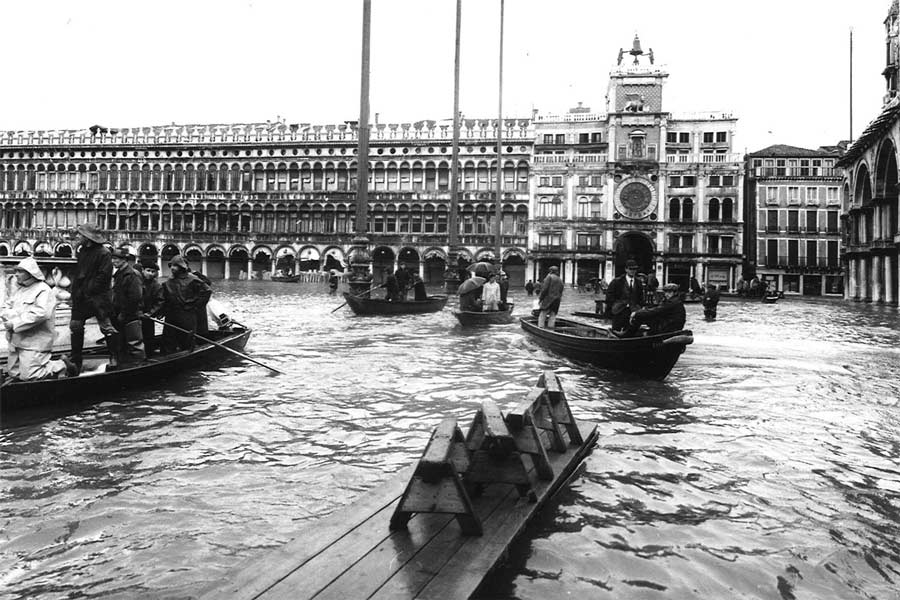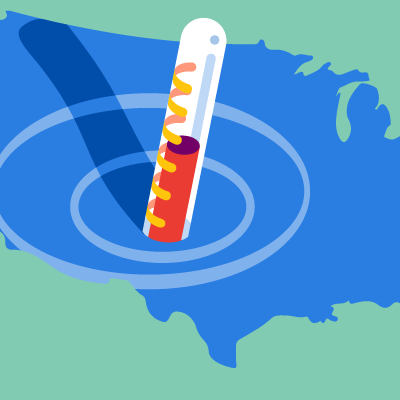
Venice has been celebrating its marriage to the sea since a military victory in the year 997, but the relationship is becoming strained. The city is famously built upon 118 islands in a shallow lagoon—an enclosed bay at the northwestern end of the Adriatic Sea—and is increasingly prone to flooding. It is currently experiencing its worst inundation since the devastating flooding of 1966, which was caused by the highest tide noted since official records began in 1923. The city’s mayor was quick to blame the current flooding on climate change, but there is more to it than that.

Going Down
The Floating City, to use just one of the many names Venice is known by, is slowly sinking. It is built on alluvial deposits that are steadily compacting under the weight of the structures built upon them. Plate tectonics are also probably contributing, as the Adriatic Plate, on which the region is located, is subducting beneath the Apennine Mountains.
The principal cause of the descent, however, is subsidence resulting from the extraction of water from deep below the lagoon. During the 20th century Venice subsided about 23 cm (9 in) in relation to sea level. The subsidence and its cause were recognized decades ago, so groundwater extraction in the area was banned in the 1960s. The sinking slowed significantly in response and was for a time thought to have stabilized, but it is continuing at the much slower rate of 1-2 mm (0.04 to 0.08 in) per year. Over the next 20 years it may still sink another 8 cm (3.2 in) in relation to sea level. According to a 2012 study the city is also slowly tilting eastward.
In addition to the sinking, Venice is flat with no hills; 78% of the city is between 110 cm (43 in) and 140 cm (55 in) above sea level, and most of the remainder is lower. When the maximum observed water elevation in Venice is 80 cm (35 in) above normal sea level, St. Mark’s Square—the lowest part of the city—floods. If it reaches 140 cm (55 in), 90% of the city is inundated. The elevation associated with the current flooding exceeded 187 cm (74 in) at a time when the predicted astronomical tide would have been around 55-60 cm (22-24 in); in 1966, when the sea level was 10 cm (4 in) lower than today, the maximum observed water elevation hit 194 cm (76 in).
Coming Up
In general the tidal range of the Mediterranean is very low, largely because of its narrow opening into the Atlantic, and it averages about 27 cm (11 in). But in the northern Adriatic, where Venice is located, Mediterranean tides reach their highest amplitude and ordinarily have a tidal range more than three times greater. Astronomical tidal activity alone is enough to bring the city dangerously close to nuisance flooding on a regular basis. Tidal flooding in Venice occurs seasonally from fall to early spring, and about four times per year causes minor flooding that usually subsides after a few hours. Exceptionally high tides are now experienced every three or four years or so and are known as acqua alta, or “high water”; these can cause more serious flooding. They occur when the regular astronomical tides combine with seasonal winds pushing water into the lagoon, and especially when storms coincide. The principal winds are the Sirocco, which blows northward up the Adriatic, and the Bora, which impacts Venice particularly because of the lagoon’s location and shape. One to two medicanes per year also generally affect the Mediterranean. The current flooding is probably attributable largely to wind-driven storm surge, perhaps exacerbated by the Adriatic seiche.
On top of a flat city that is sinking, sea levels have been rising—at twice the global average—about 6mm/yr over the last 30 years. As these levels have continued to rise from climate change, Venice’s flooding has become more frequent and may become even more frequent and more serious without further mitigation. There have been four "acqua alta” tides with a maximum observed water elevation of 140 cm (55 in) or more in the last week alone.
Effective Mitigation?
Thanks to its unique beauty, history, and treasures, Venice has been designated a UNESCO World Heritage Site and reportedly attracts 26 to 30 million tourists each year. Because of its cultural significance, fragility, and increasing vulnerability to flooding, the city will be protected by a massive flood barrier intended to isolate the lagoon.
The MOSE project (Modulo Sperimentale Elettromeccanico), ongoing since 2003, is constructing a mile-long series of 78 hollow floatable pontoons fixed to the sea bed. They can be filled with air to float upward and close off the lagoon when tides above 110 cm (43 in) are expected. MOSE is one of the largest civil engineering projects in the world, but it is years behind schedule and billions of euros over budget. It was intended to become operational in 2011 but may not be completed for some years yet and is beset with concerns about its efficacy and environmental impact.
When completed though, the pontoons should protect Venice from tides topping out at 3 meters, which should be more than enough to protect against further subsidence, future sea level rise (IPCC worst estimate is 60 cm by 2100), and hopefully any enhanced onshore winds from medicanes or other storms that may result from climate change.
It is hard to imagine Venice being abandoned, but for a variety of reasons its regular population has fallen from a peak of about 175,000 to just 55,000 today, with some 2,000 people leaving every year. Remaining residents increasingly find the first floors of their properties uninhabitable because of the flooding and are retreating to upper stories. Let’s hope that the MOSE barriers work.
"Two Recent Reports from the IPCC Up the Ante on Climate Change." Read the blog.



